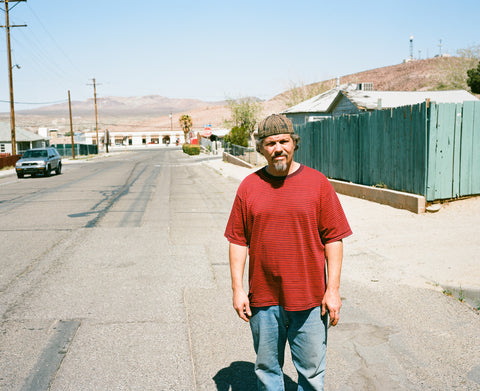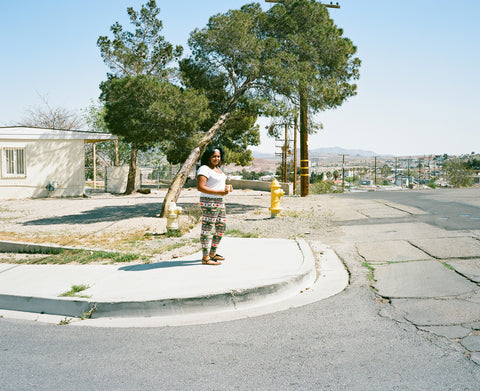In The Frame: Photographer Dave Hill on His Book "Barstow" and Shooting Film on Commercial Jobs

For many photographers with commercial aspirations, one of the names that will invariably come up as a source of inspiration is Dave Hill.
Earlier on in his career, he was known for creating complex, high-concept composite images with digital photography and Photoshop, with which he became synonymous.
His personal work harkens back to something much simpler--most of the personal images he shares on his site and social channels seem to be shot with his Leica M6.
More recently, we have gone behind the scenes with Dave on big commercial jobs he shot on film, such as for Honda and Jeep (watch those Behind the scenes videos--seriously, we'll wait), and quiet lifestyle images using only natural light.
He's obviously been very busy shooting commercial jobs--and that he has been able to convince art buyers at such high levels to approve campaigns to be shot with film is nothing short of amazing today.
But late last year, he quietly launched a book of his personal medium format film work chronicling his travels through the city of Barstow, CA. It is a quiet book full of revealing images and moments of peoples' lives in a small town. Dave took a few minutes to tell us about the book.
Tell us about yourself and your commercial work
My name’s Dave Hill. I’m from Carlsbad, CA and now live in Los Angeles with my wife and 15month old daughter. I got my start in photography in high school in the 90’s, shooting my friends skating and snowboarding. I went to UCLA for History and they had an amazing daily newspaper. I joined freshman year as an intern. We had to roll, process, and scan all of our own film, mostly TRI-X 400. The UCLA newspaper is were I really learned how to approach people without fear. It was a wild time. I became the Photo Editor my senior year in 2000. I got to spend our entire photo equipment budget that year on the new Nikon D1, so I had a very early start in digital.
That led me to spend the next 4 years after college really getting into Photoshop and compositing and creating worlds. I was also in a punk band at the time and started shooting a ton of music groups. No one was really compositing in the music scene yet, so I started to get meetings and attention from bigger artists and labels. From there, it led to a bunch of rappers and lots of CD packages, and then eventually, into the advertising world.
The entire time, though, I was regretting my obsession with Photoshop and really yearning to get back out and just shoot film with natural light. My longest break in shooting film was from 2003-2005. After those couple years of gaining weight and living in Photoshop, I bought my first Leica M6 and 35mm f2 lens on Craigslist. That was my first film cam purchase since my Nikon N70 is 1998!
So it’s taken me about 10 years from when I got that Leica, to now being finally hired for some natural light commercial jobs. It was really, REALLY tough to break out of the compositing world. At some point, I just had to accept loosing the bigger budgets and retouching fees and just go for it. The past few years I’ve really been trying to push film and at least non-composite lifestyle images to all my clients. It’s been a tough trying to impress anyone these days.
The bonus from my lack of Photoshop time has been more exploration back into street photography. I used to love shooting street and journalism stuff in college and the past 1-2 years, I’ve been taking random weekends off, documenting areas that fascinate me.

Your book "Barstow" is quite a departure from you commercial work. What is the motivation for it?
I love the desert. I always have. My dad used to take us camping to Anza-Borrego in East San Diego camping. We’d go dirt biking, shoot guns, bond with my brothers. It was awesome. We’d pass lots of random towns, including Barstow, from time to time.
As an adult, I’ve passed through Barstow on the way to Vegas like everyone else, but always had a fascination with it. My wife is awesome and a few times, we were bored in LA and decided to drive to Barstow, watch a movie at the little ghetto theater in town, and stay at the Ramada. It’s an experience. After doing that a couple times, I really wanted to explore the down more.
My wife had a baby shower weekend and I knew that was my chance. I packed up my iPhone and just my Mamiya 7 and 80mm lens and headed to Barstow. I spent the next two days walking around the city, getting yelled at and getting called a pervert. I found Barstow to be a really rough town. People didn’t respond well to me walking through their neighborhoods. I’m still fascinated why people would live in a desert town like Barstow.
Shed some light on the creation of the book
My edit was really focused on people. Sure, there were some cool/depressing old buildings out there, but I wanted to include as much of the people as possible. It was hard to toss out some of the landscapes, but I felt like my strength was how I approached the people.
I had it printed at A&I here in North Hollywood. I did a test of the bigger on-demand printers and A&I’s paper really kicked everyone else’s butt. They are a little pricey, but I felt it was worth it. I only did an initial run of 50 copies and still have a few left for sale. I feel like I’d have to sell 200-500 copies to actually make any money. With a run of 50, I actually lost money when selling the book for $30, but I did it more for art’s sake, and really wanted people to have the book in their hands, whatever it took. In the future, it might be nice to go big, print more, and make a profit!
Why did you choose to shoot this project using film?
Film was a no-brainer for me. Film looks better than digital, hands-down. The colors are unbeatable, no matter your Photoshop skill level. I shoot all my street and personal stuff on film. With projects like this Barstow book, I shoot so slow anyway, it’s not like I’m blowing through a ton of rolls. Call me silly, but I feel like when I shoot a photo on a negative, I’ve really created something. With digital, it feels like a robot just collecting data.

Do you plan to use film for any commercial work in the future, if you haven't already done so? (Editor's Note: I asked this question before his amazing Honda and Jeep behind-the-scenes videos came out!)
Yes! I’ve been spending extra money to have a camera-man come along on recent commercial car jobs, capturing the experience of shooting film. These videos have been getting a little attention in the photo world online, but my primary goal was to be able to show art buyers, who are always a little skeptical, that film on a commercial job isn’t stressful, but can be just a simple part of the workflow. Film doesn’t need to mean HOLGA/blurry/artsy/grainy/window-light nudes. Film can mean commercial shots in high-res, with beautiful colors and skin tones.
A huge thanks to Dave Hill for talking to us and helping to keep film alive and a viable option in the commercial world! Please check out Dave's website and Social profiles below, and make sure to pick up a copy of "Barstow" while you still can.
www.davehillphoto.com
instagram.com/davehillphoto
davehillphoto.tumblr.com
Link to Barstow Book - now only $15! :-)
http://www.amazon.com/gp/offer-listing/0990786706











